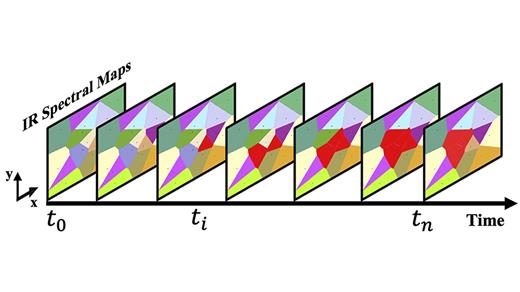Autonomous Hyperspectral Spatiochemical Imaging Delivers Faster Results and Improves Beamline Efficiency
03/28/2023

Mapping the Evolution of a Biological System. Time-resolved spatiochemical infrared mapping monitors changes in biological systems over space and time, with the goal of achieving high spatiotemporal resolution in regions of the system where chemical change is occurring. This approach aids in developing autonomous adaptive data acquisition (AADA) for time-resolved scanning hyperspectral imaging of dynamic systems. [Reprinted under a Creative Commons license (CC BY) from Holman et al. 2023. DOI: 10.1063/5.0123278]
The Summary
Autonomous experimentation is an emerging area of research that has now been extended to infrared (IR) spatiochemical mapping of dynamic biological systems. Autonomous approaches have been difficult to apply to traditionally high-dimensional mapping technologies, including scanning hyperspectral imaging, due to the inherent complexity and heterogeneity of biological samples. Scientists from the Berkeley Synchrotron Infrared Structural Biology Imaging Program (BSISB) reviewed the history of adaptive sampling algorithms and surrogate modeling and summarized recent implementations of autonomous adaptive data acquisition (AADA) methods to benefit scanning hyperspectral imaging.
IR hyperspectral imaging of biological systems is a noninvasive and label-free method for studying the time-resolved spatiochemical evolution of living biological systems. Using traditional approaches, staff scientists supporting user research activities at synchrotron facilities devote significant time to identifying regions of interest in user samples, which limits beamline efficiency and the number of users able to access the facilities. With advances in AADA, the time required to complete a user’s full data collection protocol can be significantly reduced by employing the system’s ability to autonomously and adaptively locate and analyze sample features of interest. The approach enhances overall efficiency and increases the number of users served.
Advances in autonomous experimentation—closely linked to the original concept of artificial intelligence—have traditionally been limited by two recurring primary challenges. The first is shifts in distribution due to discrepancies between training datasets and conditions during testing or deployment. The second is difficulties in transfer learning in which information gleaned from a previously learned task must be transferred to a new task. The simplest solution is to separate the autonomous experimentation workflow into distinct, actionable components individually optimized for a user’s specific structural and functional goals.
BSISB scientists conceptualize AADA as a flexible, tunable, “smart” building block framework that can be embedded into scanning hyperspectral imaging workflows to obtain high resolution and high precision chemical information from samples.
Funding
This work was supported by the Howard Hughes Medical Institute (HHMI) under Grant No. 047-101 and the U.S. Department of Energy, Office of Science, Biological and Environmental Research program under Contract No. DEAC02-05CH11231.
Related Links
- BER Resource: Berkeley Synchrotron Infrared Structural Biology Imaging Program
- American Institute of Physics Scilight: Autonomous Data Collection Allows Focus on Analysis Rather Than Acquisition
References
Holman, E.A., et al. 2023. “Toward Implementing Autonomous Adaptive Data Acquisition for Scanning Hyperspectral Imaging of Biological Systems,” Applied Physics Reviews 10, 011319. DOI:10.1063/5.0123278.
